 | | 2025-2029 Transportation Improvement Program Approved | The Kane County Board recently approved the 2025-2029 Transportation Improvement Program, known as the TIP. The TIP contains the 5-year capital plan for the Division of Transportation. It provides information to the public on the expected revenues and expenditures and the projects planned for implementation during the 5-year timeframe. Click on this link to view the approved plan. The new interactive web app has been updated with the 2025-2029 TIP information. This web app allows users to view the projects in greater detail. The user can view by project category, location, County Board District, and more.
Click on this link to view the updated interactive TIP map.  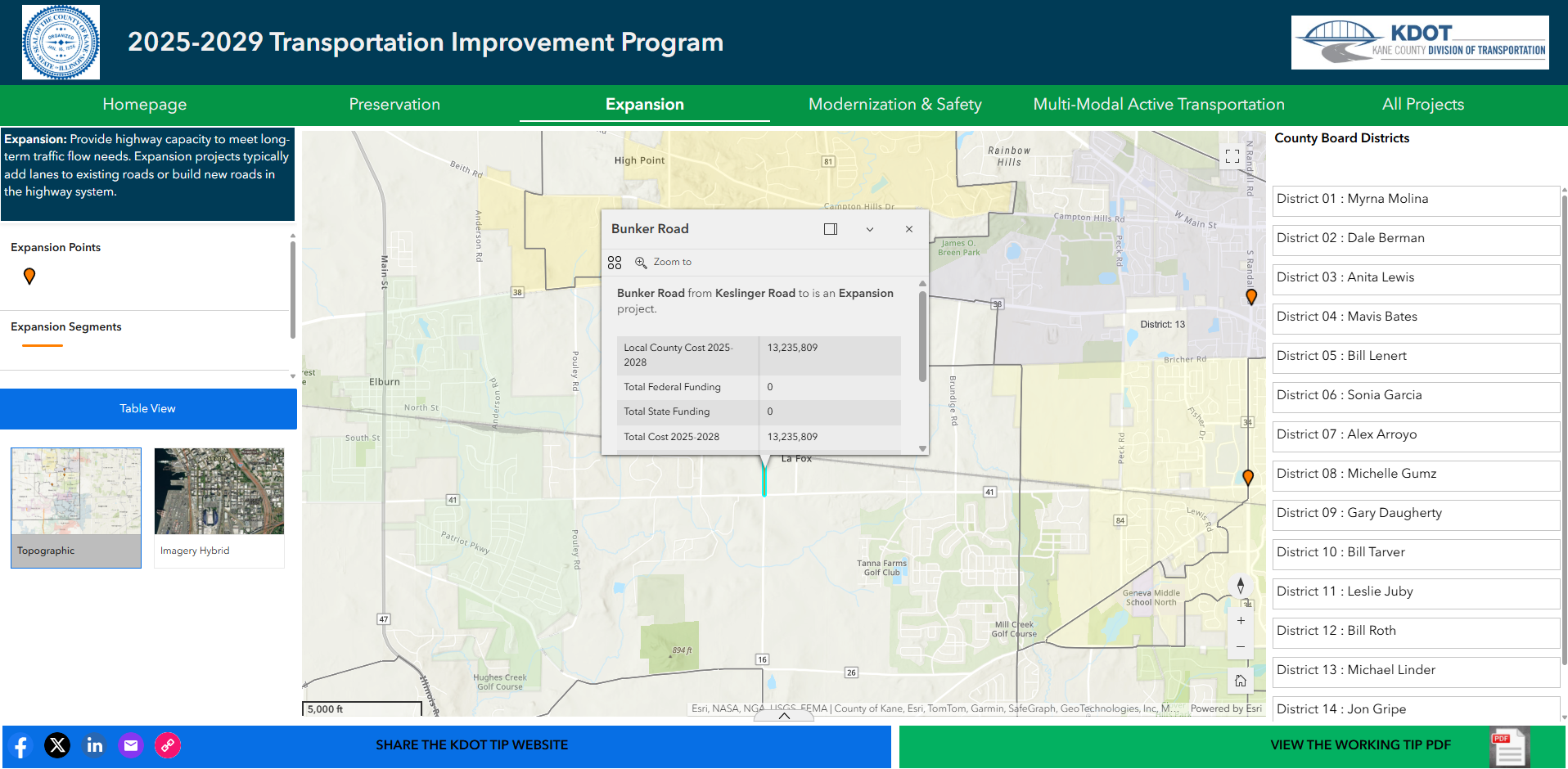
|  |  | | Randall Road at Hopps Road | The Kane County Division of Transportation has retained the professional services of Christopher B. Burke Engineering, Ltd. to complete a Phase I Engineering Study for Improvements along Randall Road at Hopps Road, within the City of Elgin, Village of South Elgin and Elgin Township. The purpose of this project is to provide route continuity and capacity improvements along Randall Road based on the projected substantial growth in traffic volumes for the year 2050, as well as additional safety enhancements at the intersection of Randall Road and Hopps Road. Based on projected traffic growth, capacity improvements are needed along Randall Road to add a 3rd lane in each direction, tying into existing six-lane sections at both the northern and southern project limits. In addition, a grade separation of the Canadian National Railroad (CNRR) is proposed to address congestion caused by the at-grade crossing with the Canadian National Railroad (CNRR) and to optimize safety at the CNRR crossing with the projected future traffic growth within the project corridor. The Phase I Engineering Study evaluated three alternatives for the intersection of Randall Road and Hopps Road using travel performance, safety, footprint and cost measures. In addition, a grade separation alternatives evaluation was completed for both an underpass and overpass alternative, looking at constructability and cost measures. The Preferred Alternative includes a realignment of Randall Road and Hopps Road to improve the intersection angle to 75-degrees and remove superelevation from the intersection, and a grade separation of Randall Road over the Canadian National Railroad. As part of this improvement, the project will also add a 3rd lane in each direction along Randall Road, with a new enclosed drainage system. A multi-use path will be constructed on the west side of Randall Road, closing an existing gap. Project Manager: Jennifer O'Connell, Chief of Design 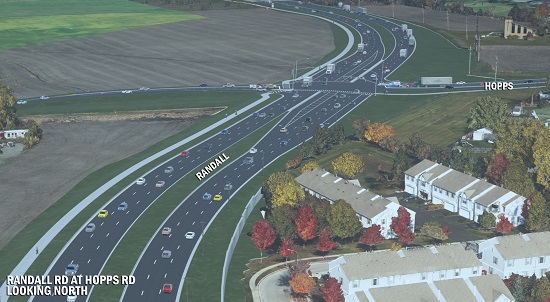 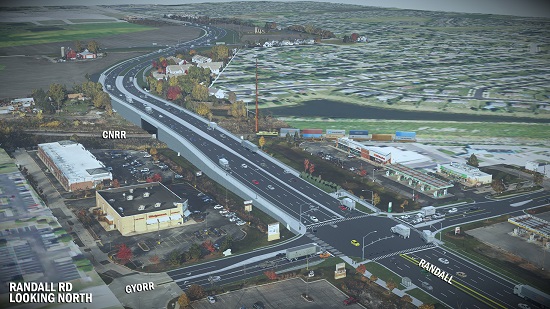 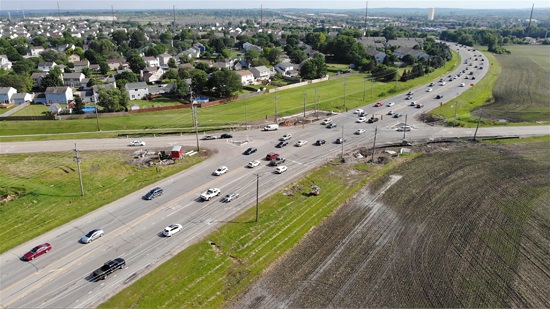
|  |  | | Residents Invited to Attend One of Two Public Information Meetings about Proposed Randall Road Multimodal Improvements |
The Kane County Division of Transportation (KDOT) invites travelers and residents of Elgin, Elgin Township, Dundee Township, Sleepy Hollow, West Dundee, Carpentersville and Algonquin to attend one of two public meetings in February 2025 regarding proposed multimodal improvements along Randall Road. Randall Road is an important County roadway that serves between 35,000 and 50,000 vehicles daily. The corridor is home to a
variety of busy commercial centers, recreational facilities and residential areas. To create a more accessible roadway for bicyclists, pedestrians and transit riders alike, KDOT is conducting a Phase I preliminary engineering and environmental study on an approximately nine-mile stretch of Randall Road. This study will develop and review alternatives for the construction of new sidewalks, shared-use paths and intersection signal upgrades. Following two public information meetings held in September 2023 and subsequent rounds of stakeholder engagement in 2024, KDOT is seeking public input on the proposed Randall Road multimodal improvements. The proposed improvements are only for pedestrian accommodations along Randall Road between College Green Drive in Elgin and County Line Road in Algonquin. For residents’ convenience, one meeting will be held in each of the two study corridors: south and north. During both meetings, the project team will share the identical information about the study in an open house format, gather public input and review the next steps. Meeting dates and locations are as follows: • South meeting: Tuesday, February 4 from 5 to 7 p.m. at Elgin Community College Building E (1700 Spartan Drive, Elgin, IL 60123) • North meeting: Thursday, February 6 from 5 to 7 p.m. at Algonquin Village Hall (2200 Harnish Drive, Algonquin, IL 60102) Public comments and questions can also be submitted both before and after the meeting until Friday, February 28, by contacting Jordan Rogalski, Randall Road Multimodal Improvements Outreach Liaison at jrogalski@metrostratgroup.com or 630-534-6400 ext. 104. Persons that require special accommodations should submit requests to Jordan Rogalski, Randall Road Multimodal Improvements Outreach Liaison, at 630-534-6400 ext. 104 or at jrogalski@metrostratgroup.com for further assistance by Friday, January 31. Spanish interpretation will be made available upon resident request.
|  |  | | Longmeadow Parkway Bridge Corridor Grand Opening of the New Fox River Bridge | Drivers are now motoring across a new bridge in northern Kane County. The Longmeadow Parkway Bridge Corridor opened to the public on August 29, 2024.
The cornerstone of the $200 million project is a new bridge that provides an additional route over the Fox River. The entire corridor stretches 5.6 miles, from Huntley Road to Route 62, and includes a bike and pedestrian path connecting to the Fox River Trail. The opening was celebrated with a ribbon-cutting event attended by over 175 people including Governor JB Pritzker, Kane County elected officials, members of the Kane County Division of Transportation, state lawmakers, and local leaders. Originally, Kane County planned to fund the bridge construction with tolls. However, over the past two years, the County successfully secured an additional $30 million in state funding to cover the costs. As a result, the bridge was completed without imposing tolls. .png) 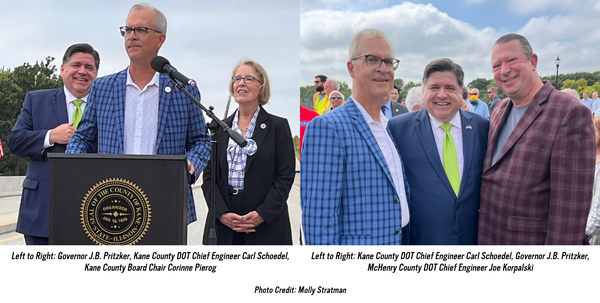
|  |  | | Visibility Through Roundabouts |
Why does KDOT typically put taller vegetation blocking visibility through the central island of their roundabouts?
Thought and planning goes into the native landscaping found in the central islands of our roundabouts. While there is nothing fundamentally wrong with seeing the upstream approach of cars from a long ways off and timing your own approach accordingly, the real value in sight distance restrictions provided by taller vegetation in the roundabout is the positive effect they have on those vehicles getting ready to enter the roundabout. As vehicles are getting ready to enter the roundabout, restricting sight distance across the central island with strategic taller landscaping may enhance the safety of the intersection by encouraging lower speeds and making only the left-hand side of the roundabout the focal point. In addition to the increased aesthetic value, a well-landscaped island will make both circulating and entering vehicles more cautious by limiting how far ahead they can see. A circulating vehicle likely will be a bit slower around the curve if its view ahead is restricted (see graphics below). That makes it easier for a car entering the circulating lane to receive a reasonable gap. If sight distance restrictions can limit circulating vehicles to 20 mph, you need less than 120 feet of pavement to provide a four-second entry gap – which is big enough for just about any passenger car. An additional characteristic of taller central island landscaping is that it shields the headlights of oncoming vehicles making it easier to see the circulating lane as a driver approaches a roundabout.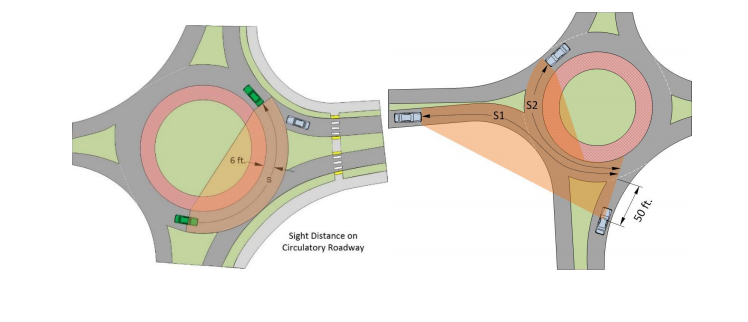
Graphic credit: WisDOT
|  |  | | Bids and Letting Updated Information | Kane County Purchasing Department now uses BidNet's Illinois Purchasing Group to advertise and manage our Bids and Addenda. Registering and using this service is free. Please click here to visit the BidNet Illinois Purchasing Group page. All active solicitations for KDOT construction and maintenance projects can be found on this site.Please note that KDOT does not use this service to select for professional services.
|  |
|
